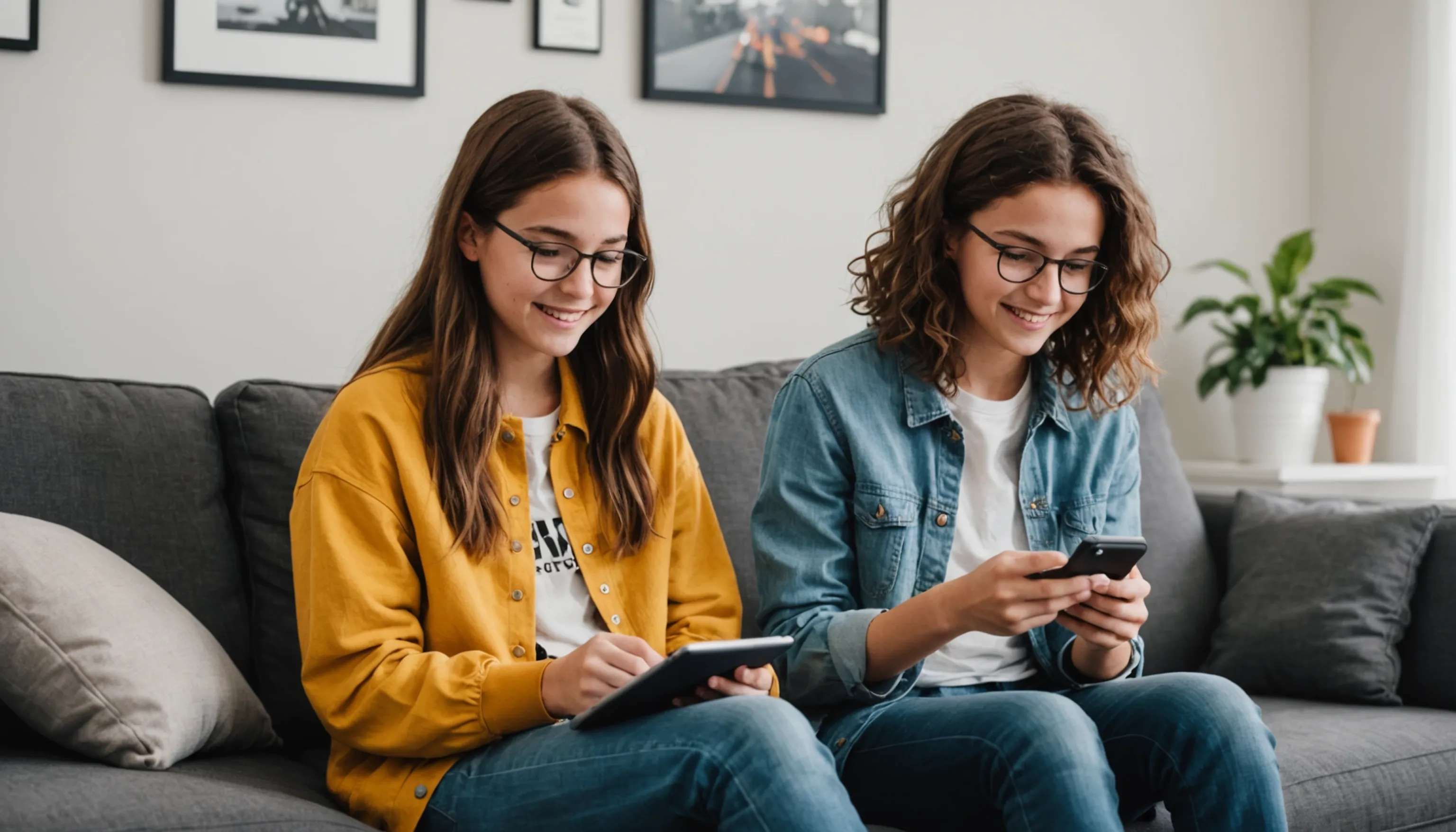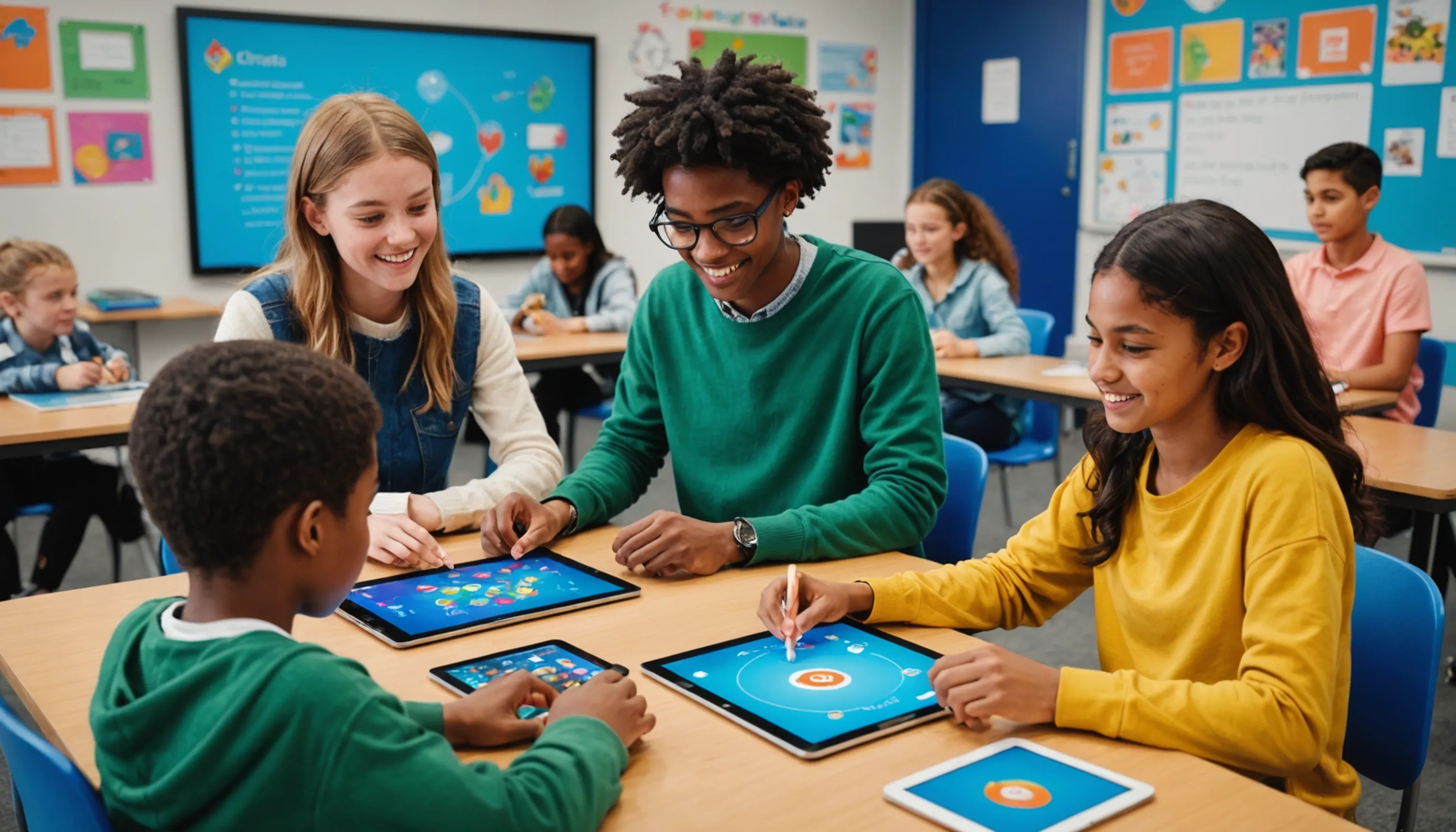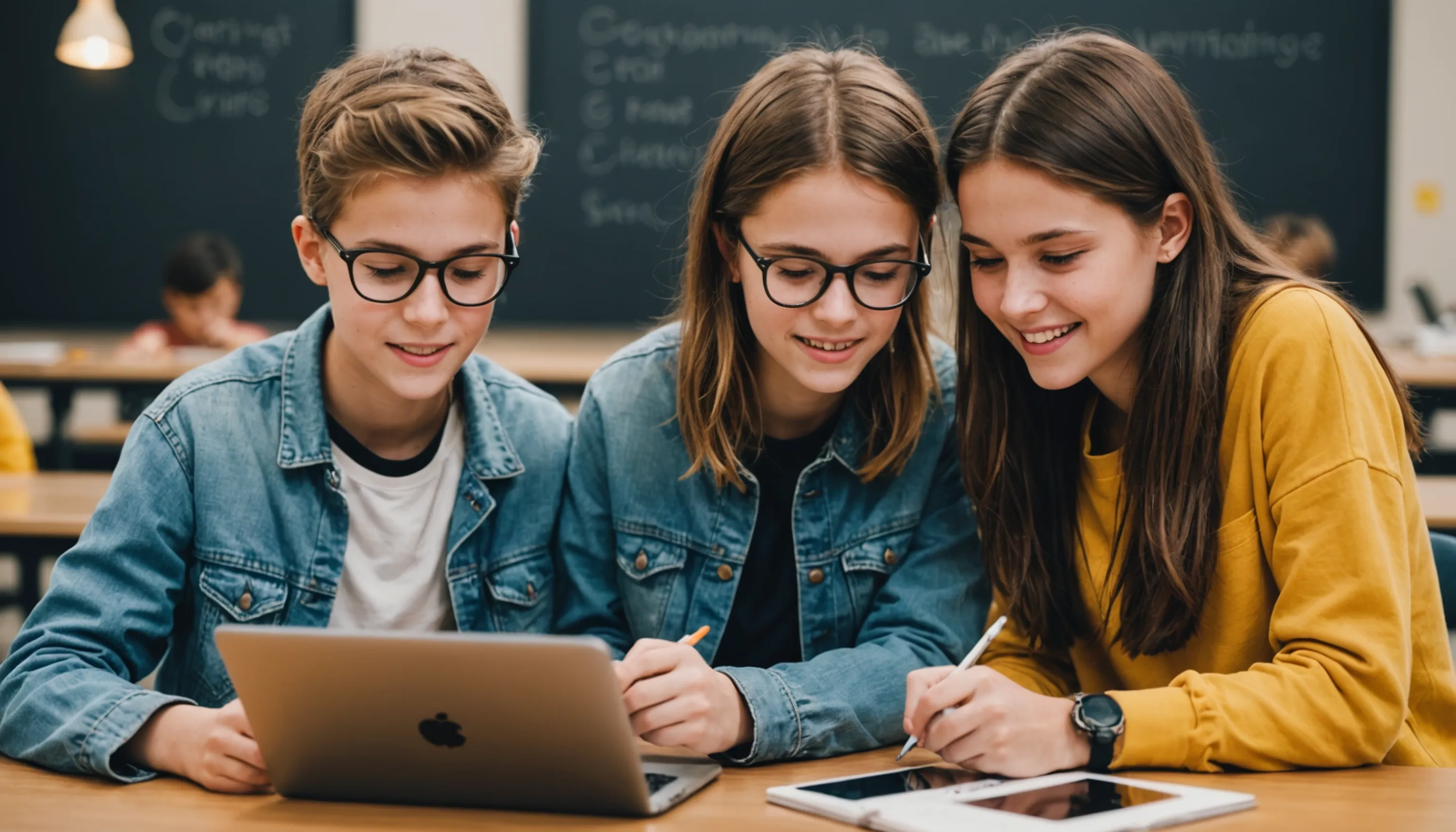Meaningful Screen Time Activities for Education
 HvWHenry van Wagenberg
HvWHenry van Wagenberg
Meaningful Screen Time Activities for Teenagers
In today's digital age, it’s crucial to engage teenagers in meaningful screen time activities that promote learning and development. These activities can enhance their skills while keeping them entertained.
Examples include utilizing educational apps for interactive learning, enrolling in online courses, and participating in webinars. Engaging in interactive learning games can also make education fun, while creative digital projects like digital art or video production foster creativity and technical skills.
Encouraging teenagers to explore these activities can transform screen time into an enriching experience.
Educational Apps for Learning
With the rise of technology, educational apps have become essential tools for enhancing learning among teenagers. These apps provide interactive and engaging ways to absorb information, making education more appealing. Numerous platforms cater to different subjects and learning styles, ensuring that every student can find something suited to their needs.
Some popular categories of educational apps include:
- Math and Science: Apps like Khan Academy and Photomath help students grasp complex concepts through tutorials and problem-solving tools.
- Language Learning: Applications such as Duolingo and Babbel make learning new languages fun through gamified lessons and quizzes.
- Reading and Writing: Platforms like Epic! and Grammarly enhance literacy skills by providing access to a vast library of books and writing assistance.
Moreover, many educational apps incorporate features like progress tracking and personalized learning paths, which help students stay motivated and focused. By allowing teenagers to learn at their own pace, these apps can significantly boost their confidence and academic performance.
Incorporating educational apps into daily routines can transform mundane screen time into valuable learning experiences. Parents and teachers can encourage teenagers to explore these tools, fostering a lifelong love for learning while also ensuring they make the most of their screen time.
Online Courses and Webinars
Online courses and webinars have revolutionized the way teenagers access education. With a wide range of topics available, these platforms allow students to learn from the comfort of their homes, making education more flexible and accessible.
One of the key benefits of online courses is the ability to learn at one's own pace. Platforms like Coursera, edX, and Udemy offer courses in various subjects, from mathematics and science to art and technology. These courses often include video lectures, quizzes, and interactive assignments, enabling students to engage deeply with the material.
Webinars, on the other hand, provide a more interactive learning experience. They often feature experts in various fields who share their insights and knowledge in real-time. Students can participate in discussions, ask questions, and connect with peers from around the world. This interaction can enhance the learning experience and foster a sense of community among participants.
Additionally, many online courses and webinars offer certificates upon completion, which can be beneficial for college applications or future job opportunities. By encouraging teenagers to explore these resources, parents and teachers can help them develop essential skills and knowledge that will serve them well in their academic and professional futures.
Ultimately, integrating online courses and webinars into a teenager's learning routine can lead to a more enriched educational experience, turning screen time into a powerful tool for growth and development.

Interactive Learning Games
Interactive learning games have emerged as a dynamic and engaging way for teenagers to absorb new concepts while having fun. These games combine education with entertainment, making them a perfect tool for turning screen time into productive learning experiences.
Many educational platforms offer a variety of interactive games that cater to different subjects, such as math, science, and language arts. For instance, websites like Kahoot! and Quizlet allow students to participate in quizzes and challenges that reinforce their understanding of the material. These platforms often incorporate competitive elements, encouraging teenagers to engage with their peers while enhancing their knowledge.
Another popular type of interactive learning game is simulation games. For example, games like SimCity and Kerbal Space Program not only entertain but also teach valuable lessons about urban planning, physics, and problem-solving. These simulations require players to think critically and make strategic decisions, skills that are essential in real-world scenarios.
Furthermore, interactive learning games can be tailored to meet individual learning needs. Many platforms adapt the difficulty level based on a player’s performance, ensuring that students are challenged without feeling overwhelmed.
By integrating interactive learning games into their routine, teenagers can enjoy a fun and effective way to learn new concepts and reinforce existing knowledge. Parents and teachers can encourage the use of these games as a means of balancing screen time with valuable educational experiences.
Creative Digital Projects
Creative digital projects offer teenagers a fantastic way to express themselves while honing their skills in technology and design. These projects can include digital art, video production, graphic design, and even coding. For instance, platforms like Canva and Adobe Spark enable students to create stunning visuals and presentations.
Additionally, teenagers can explore their storytelling abilities through video editing tools such as iMovie or Adobe Premiere. Engaging in these creative endeavors not only fosters creativity but also builds essential skills that are valuable in today’s digital world.
Digital Art and Design
Digital art and design have gained immense popularity among teenagers as a creative outlet that allows them to explore their artistic talents while leveraging technology. With a plethora of software and tools available, young artists can create stunning visuals, illustrations, and animations that showcase their unique styles.
Programs like Adobe Photoshop, Procreate, and Corel Painter provide powerful features for drawing and painting, making it easier for teenagers to experiment with colors, textures, and techniques. These tools enable users to create everything from digital paintings to intricate designs and graphics.
Moreover, online platforms like Behance and DeviantArt allow teenagers to share their work with a wider audience, receive feedback, and connect with other budding artists. This sense of community can be incredibly encouraging and help them refine their skills through collaboration and critique.
Participating in digital art and design projects also enhances essential skills such as creativity, critical thinking, and problem-solving. Many educational institutions now incorporate digital art into their curricula, recognizing its importance in developing a well-rounded skill set. Additionally, these skills can lead to exciting career opportunities in fields like graphic design, animation, and game development.
Encouraging teenagers to explore digital art and design can transform their screen time into a productive and enriching experience, fostering a passion for creativity that can last a lifetime.

Video Production and Editing
Video production and editing have become increasingly popular among teenagers, providing them with a platform to express their creativity and storytelling abilities. With the rise of social media and video-sharing platforms like YouTube and TikTok, young creators are finding new ways to engage audiences through dynamic video content.
Teens can learn the basics of video production using user-friendly software such as iMovie, Adobe Premiere Pro, and Final Cut Pro. These tools enable them to shoot, edit, and produce high-quality videos, from short clips to full-length films. Students can explore various techniques, including transitions, effects, and sound editing, which enhance the overall quality of their projects.
Moreover, many online courses and tutorials are available that focus on video production and editing skills. Websites like Skillshare and YouTube provide valuable resources for beginners, allowing them to gain confidence and improve their technical abilities.
Engaging in video production also fosters teamwork and collaboration when teens work on group projects. They can take on various roles such as director, camera operator, or editor, which helps develop communication and leadership skills. Additionally, creating video content can be an effective way for teens to document their experiences, express their opinions, and share their passions with the world.
By encouraging teenagers to explore video production and editing, parents and educators can help them transform their screen time into a creative, educational experience that prepares them for future opportunities in media and communication.
Coding and Programming Activities
Coding and programming activities have become essential in today’s digital landscape, offering teenagers the opportunity to develop critical thinking and problem-solving skills. As technology continues to advance, understanding the basics of coding is increasingly important, making it a valuable addition to a teenager's educational experience.
There are various platforms available that cater to different skill levels, from beginners to advanced coders. Websites like Codecademy, Scratch, and FreeCodeCamp provide interactive lessons and projects that teach programming languages such as Python, JavaScript, and HTML. These platforms often use gamification elements to make learning more engaging and enjoyable.
Participating in coding activities can also involve working on real-world projects, such as developing websites, creating apps, or even programming robots. This hands-on experience not only solidifies their learning but also allows teenagers to showcase their skills in tangible ways.
Furthermore, coding promotes collaboration through group projects and hackathons, where teens can work together to solve problems and create innovative solutions. These events foster teamwork, creativity, and communication skills, which are essential in any professional environment.
By encouraging teenagers to engage in coding and programming activities, parents and educators can equip them with valuable skills for the future. As technology continues to shape our world, the ability to code can open doors to numerous career opportunities, making it a worthwhile investment of their time and screen time.
Collaborative Online Learning Platforms
Collaborative online learning platforms have transformed the way teenagers engage in education. These platforms, such as Google Classroom, Edmodo, and Moodle, allow students to connect, share resources, and work together on projects from anywhere in the world.
By facilitating group discussions, file sharing, and real-time collaboration, these tools enhance communication and teamwork skills. They also provide access to diverse perspectives and ideas, enriching the learning experience. Encouraging teenagers to utilize these platforms can foster a sense of community and cooperation, making learning more interactive and enjoyable.
Virtual Study Groups
Virtual study groups have become an essential tool for teenagers seeking to enhance their learning experience. These online collaborations enable students to connect with peers, share knowledge, and tackle challenging subjects together, regardless of their physical location. Using platforms like Zoom, Microsoft Teams, and Discord, teenagers can create a virtual environment conducive to focused study sessions.
One of the key benefits of virtual study groups is the ability to leverage diverse perspectives. Each member may have different strengths and weaknesses, allowing them to support one another in areas where they might struggle. This collaborative approach not only enhances understanding but also boosts confidence.
Additionally, virtual study groups can help students develop essential skills such as communication, teamwork, and time management. By setting goals and organizing study schedules, participants learn to hold each other accountable, making their study sessions more productive.
Using shared digital tools like Google Docs or Quizlet, members can collaborate on projects, create study guides, and quiz each other on important topics. These resources make it easier to consolidate information and prepare for exams effectively.
Encouraging teenagers to participate in virtual study groups can significantly enhance their academic performance while fostering social connections. As they navigate their educational journeys, these collaborative experiences can make learning more enjoyable and less isolating, ultimately contributing to their overall success.
Discussion Forums and Educational Communities
Discussion forums and educational communities have become vital resources for teenagers seeking to enhance their learning experience and connect with peers. These platforms, such as Reddit, Stack Exchange, and Edmodo, provide spaces for students to ask questions, share insights, and engage in meaningful discussions about various subjects.
One of the significant advantages of participating in these forums is the access to a wealth of knowledge. Students can find answers to specific questions, explore different perspectives, and learn from the experiences of others. This collaborative environment fosters critical thinking, as teenagers are encouraged to analyze information and form their own opinions.
Moreover, discussion forums often host topics ranging from academic subjects to extracurricular interests, allowing students to explore areas they are passionate about. Engaging in discussions can help them develop communication skills and confidence in expressing their thoughts and ideas.
Additionally, educational communities provide a sense of belonging and support. Many teenagers find comfort in connecting with others who share similar interests or challenges, creating a network of friends and mentors. This social aspect can enhance motivation and commitment to their studies.
Encouraging teenagers to participate in discussion forums and educational communities can significantly enrich their learning experiences. These platforms not only promote academic growth but also foster social connections, making education a more collaborative and engaging journey.
